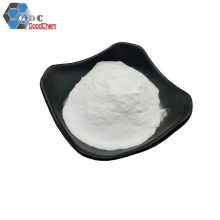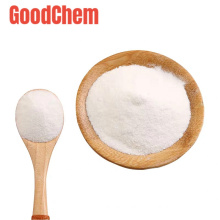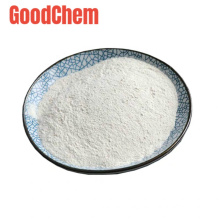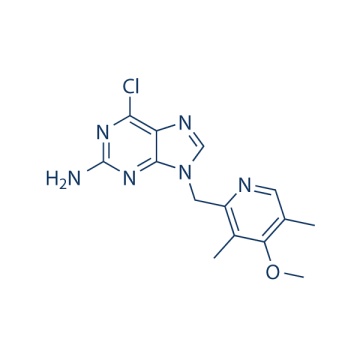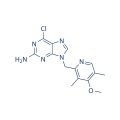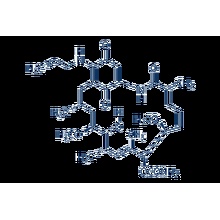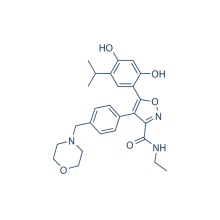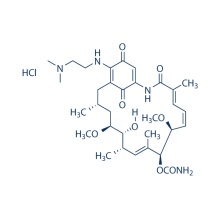.cp_wz table {border-top: 1px solid #ccc; border-left: 1px solid #ccc; } .cp_wz table td {border-right: 1px solid #ccc; borda inferior: 1px sólido #ccc; preenchimento: 5px 0px 0px 5px;} .cp_wz tabela th {border-right: 1px solid #ccc; border-bottom: 1px solid #ccc; preenchimento: 5px 0px 0px 5px;} \ n Peso molecular: \ n 318,76 BIIB021 é um inibidor de moléculas pequenas totalmente sintético, disponível por via oral, de HSP90 com Ki e EC50 de 1,7 nM e 38 nM, respectivamente. Fase 2. \ n Atividade biológica BIIB021 liga-se ao bolso de ligação de ATP de Hsp90, interfere com a função chaperona de Hsp90 e resulta na degradação da proteína cliente e na inibição do crescimento do tumor. BIIB021 inibe a proliferação de células tumorais (BT474, MCF-7, N87, HT29, H1650, H1299, H69 e H82) com IC50 de 0,06-0,31 μM. BIIB021 induz a degradação de proteínas cliente Hsp90 incluindo HER-2, Akt e Raf-1 e expressão regulada positivamente das proteínas de choque térmico Hsp70 e Hsp27. BIIB021 inibe as células do linfoma de Hodgkin (KM-H2, L428, L540, L540cy, L591, L1236 e DEV) com IC50 de 0,24-0,8 μM. BIIB021 mostra baixa atividade em linfócitos de indivíduos saudáveis. BIIB021 inibe a atividade constitutiva de NF-κB apesar do IκB defeituoso. O BIIB021 induz a expressão de ligantes para o receptor de células NK ativador NKG2D em células de linfoma de Hodgkin, resultando em um aumento da suscetibilidade à morte mediada por células NK. BIIB021 aumentou a radiossensibilidade in vitro de linhas de células HNSCCA (UM11B e JHU12) com uma redução correspondente na expressão de proteínas radiorresponsivas chave, aumento de células apoptóticas e aumento da parada G2. O BIIB021 é consideravelmente mais ativo do que o 17-AAG contra o carcinoma adrenocortical H295R, tanto in vitro quanto in vivo. A atividade citotóxica de BIIB021 não é influenciada pela perda de NQO1 ou superexpressão de Bcl-2, lesões moleculares que não evitam a perda do cliente, mas estão associadas à redução da morte celular por 17-AAG. BIIB021 também é ativo em linhas de células resistentes a 17-AAG (NIH-H69, MES SA Dx5, NCI-ADR-RES, Nalm6 e etc.). A administração oral de BIIB021 leva à inibição do crescimento tumoral em muitos modelos de xenoenxerto de tumor, incluindo N87, BT474, CWR22, U87, SKOV3 e Panc-1. O BIIB021 inibe efetivamente o crescimento do tumor L540cy com uma dose de 120 mg / kg. BIIB021 aumenta significativamente o efeito de crescimento antitumoral da radiação no xenoenxerto JHU12. Ensaio de cinase de protocolo (apenas para referência): [1]
|
Hsp90 Binding Assay
|
For fluorescence polarization competition measurements, the FITC-geldanamycin probe (20 nM) is reduced with 2 mM TCEP at room temperature for 3 hours, after which the solution is aliquoted and stored at -80 °C until used. Recombinant human Hsp90α (0.8 nM) and reduced FITC-geldanamycin (2 nM) are incubated in a 96-well microplate at room temperature for 3 hours in the presence of assay buffer containing 20 mM HEPES (pH 7.4), 50 mM KCl, 5 mM MgCl2, 20 mM Na2MoO4, 2 mM DTT, 0.1 mg/mL BGG, and 0.1% (v/v) CHAPS. Following this preincubation, BIIB021 in 100% DMSO is then added to final concentrations of 0.2 nM to 10 μM (final volume 100 μL, 2% DMSO). The reaction is incubated for 16 hours at room temperature and fluorescence is then measured in an Analyst plate reader, excitation = 485 nm, emission = 535 nm. High and low controls contained no BIIB021 or no Hsp90, respectively. The data are fit to a four-parameter curve and IC50 is generated.
|
|
HER-2 Degradation Assay
|
MCF-7 cells (5 × 105) in complete DMEM are seeded per well in 24-well plates. The cells are propagated for 24 hours before BIIB021 addition. BIIB021 (1 mM) is prepared in DMSO and serially diluted in complete DMEM. Cells are incubated in the pr
|
Ensaio de células: [1]
|
Cell lines
|
BT474, MCF-7, N87, HT29, H1650, H1299, H69 and H82 cells
|
|
Concentrations
|
3 nM - 1 μM
|
|
Incubation Time
|
5 days
|
|
Method
|
A modified tetrazolium salt assay is used to measure the IC50. Tumor cells are added to 96-well plates and propagated for 24 hours before BIIB021 addition. BIIB021 is added to the plated cells. DMSO (0.03-0.003%) is included as a vehicle control. After incubation phenazine methosulfate (stock concentration 1 mg/mL) and 3-(4,5-dimethylthiazol-2-yl)-5-(3-carboxymethoxyphenyl)-2-(4-sulfophenyl)-2H-tetrazolium, inner salt (stock concentration 2 mg/mL) are mixed at a ratio of 1:20 and added to each well of a 96-well plate. Reduction of 3-(4,5-dimethylthiazol-2-yl)-5-(3-carboxymethoxyphenyl)-2-(4-sulfophenyl)-2H-tetrazolium, inner salt gives rise to a soluble formazan product that is secreted into the culture medium. After 4 hours incubation, the formazan product is quantitated spectrophotometrically at a wavelength of 490 nm. Data are acquired using SOFTmaxPRO software, and 100% viability is defined as the A490 of DMSO-treated cells stained with 3-(4,5-dimethylthiazol-2-yl)-5-(3-carboxymethoxyphenyl)-2-(4-sulfophenyl)-2H-tetrazolium, inner salt (the mean A490 of cells treated with DMSO at a range of 0.03-0.003%). Percent viability of each sample is calculated from the A490 values as follows: % viability = (A490 nm sample / A490 nm DMSO-treated cells × 100). The IC50 is defined as the concentration that gives rise to 50% inhibition of cell viabilit
|
Estudo Animal: [1]
|
Animal Models
|
N87, BT474, CWR22, U87, SKOV3 and Panc-1 tumor models in BALB/c and athymic mice
|
|
Formulation
|
Phospho-lipon/sucrose emulsion [2]
|
|
Dosages
|
31, 62.5, and 125 mg/kg
|
|
Administration
|
Orally administered once daily
|
|
Solubility
|
30% propylene glycol, 5% Tween 80, 65% D5W,
30 mg/mL
|
|
* Please note that Selleck tests the solubility of all compounds in-house, and the actual solubility may differ slightly from published values. This is normal and is due to slight batch-to-batch variations.
|
Conversão de diferentes modelos de animais com base em BSA (valor com base em dados das diretrizes preliminares da FDA)
|
Species
|
Baboon
|
Dog
|
Monkey
|
Rabbit
|
Guinea pig
|
Rat
|
Hamster
|
Mouse
|
|
Weight (kg)
|
12
|
10
|
3
|
1.8
|
0.4
|
0.15
|
0.08
|
0.02
|
|
Body Surface Area (m2)
|
0.6
|
0.5
|
0.24
|
0.15
|
0.05
|
0.025
|
0.02
|
0.007
|
|
Km factor
|
20
|
20
|
12
|
12
|
8
|
6
|
5
|
3
|
|
Animal A (mg/kg) = Animal B (mg/kg) multiplied by
|
Animal B Km
|
|
Animal A Km
|
Por exemplo, para modificar a dose de resveratrol usada para um camundongo (22,4 mg / kg) para uma dose baseada na BSA para um rato, multiplique 22,4 mg / kg pelo fator Km para um camundongo e, em seguida, divida pelo fator Km para um rato. Este cálculo resulta em uma dose equivalente de rato para o resveratrol de 11,2 mg / kg.
|
Rat dose (mg/kg) = mouse dose (22.4 mg/kg) ×
|
mouse Km(3)
|
= 11.2 mg/kg
|
|
rat Km(6)
|
Informação Química
|
Molecular Weight (MW)
|
318.76
|
|
Formula
|
C14H15ClN6O
|
|
CAS No.
|
848695-25-0
|
|
Storage
|
3 years -20℃Powder
|
|
6 months-80℃in solvent (DMSO, water, etc.)
|
|
Synonyms
|
CNF2024
|
|
Solubility (25°C) *
|
In vitro
|
DMSO
|
64 mg/mL
(200.77 mM)
|
|
Water
|
<1 mg/mL
(
|
|
Ethanol
|
2 mg/mL
(6.27 mM)
|
|
In vivo
|
30% propylene glycol, 5% Tween 80, 65% D5W
|
30 mg/mL
|
* <1 mg/ml means slightly soluble or insoluble.
* Please note that Selleck tests the solubility of all compounds in-house, and the actual solubility may differ slightly from published values. This is normal and is due to slight batch-to-batch variations.
|
|
Chemical Name
|
6-chloro-9-((4-methoxy-3,5-dimethylpyridin-2-yl)methyl)-9H-purin-2-amine
|
Calculadora de molaridade Calculadora de diluição Calculadora de peso molecular
Grupo de Produto : Sinalização Citoesquelética > Inibidor HSP
